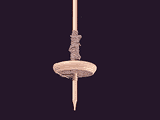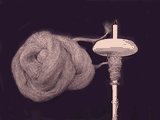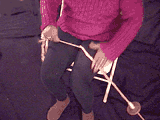WHO WE ARE
About Us
How I Started Handspinning
DROP SPINDLES
*Types of Drop Spindles
How To Make A Drop Spindle
Making Yarn With A Drop Spindle 
SPINNING WHEELS
Styles of Spinning Wheels
Parts Of The Spinning Wheel
*How The Spinning Wheel Works
* Adjusting The Wheel's Tension
*Drive Ratios & Twist
HANDSPINNING TECHNIQUES
Preparing To Spin 
Basic Handspinning Techniques 
Adding On More Fiber 
Spinning Woollen and Worsted Yarn
*Making A Skein With A Niddy Noddy
* "Setting In The Twist" Of Handspun Yarn
*Navajo Plying 
FIBER INFORMATION
Alpaca 
Angora 
Llama 
Mohair 
Silk
Wool 
WOOL PREPARATION
How to Wash Your Fleece
How to Use Hand Carders 
How to Use a Drum Carder
How to Use Dutch Combs
How to Use Mini-Combs
Using a Diz
DYEING INFORMATION
Natural Dyes
Natural Plant Dyeing
Mordants
Natural Dyeing: Helpful Tips
Dyeing with Gaywool Dyes
BUY EQUIPMENT & SUPPLIES
ONLINE PRODUCT CATALOG
Return Policy
Payment Options
Mail-in Order Form
*THE BOOK STORE
WOOLY WABBIT(TM) FARM
Meet the "Wooly Wabbits" 
Angora Rabbit Breeds
How to Care For Your Angora Rabbit
FEEDBACK
REQUEST INFORMATION
RELATED LINKS
*
WORLDWIDE LIST OF
SPINNING GUILDS
|
Types of Drop Spindles
For centuries, the handspindle played a role in producing thread and yarn. It is still a tool used in parts of the
world today. The form and function of the spindle is basically the same everywhere. It has a very simple
design consisting of a shaft and a weight. The materials used to make the spindle in the past consisted
of whatever was readily available at the time. The majority of the spindles available today, have wooden
shafts with a wooden disc as the whorl (weight). Choosing the type of spindle to use, will be determined
by the type of yarn you want to produce, and the type of fiber being used. There are basically two types of
spindles; suspended and supported.
  Bottom / Low Whorl Spindle
Bottom / Low Whorl Spindle
This type of spindle is commonly referred to as the drop spindle. It is widely used in Europe and easily found in
the United States. The whorl is located at the bottom of the shaft and there is either a hook or a notch at the top of
the shaft to catch the yarn. The spun yarn is wound onto the shaft directly above the whorl.
The bottom-whorl spindle is a suspended spindle and is best suited for spinning thicker yarns and heavier fibers.
With the weight at the bottom of the shaft, the spindle will spin slower (low-whorl spindle). Therefore,
a bottom-whorl spindle is too heavy and too slow for spinning thin yarn and soft fiber.
The spindle rotates freely suspended from the yarn leaving both hands free to hold and draft the fiber. The
spun yarn is released from the hook of the spindle and wound onto the staff directly above the whorl.

  Top / High Whorl Spindle
Top / High Whorl Spindle
A top-whorl spindle is also a suspended spindle and has the whorl at the top of the shaft and is usually lightweight. There is a hook on top of
the spindle just above the whorl for catching the yarn. Top-whorl spindles rotate at a higher speed
(high-whorl spindle), which makes them ideal for spinning thin yarn and fine fibers. It is believed that
the top-whorl spindle originated in the Middle East.

  Navajo Spindle
Navajo Spindle
The Navajo spindle is an example of a supported spindle. It has a long shaft and a heavy whorl,
which makes it too heavy to be spun while being suspended in the air. The spindle has a shaft about 30"
long for use while sitting on the floor, or 33" long if used from a chair. The whorl is near the bottom of the
shaft and is about 4" in diameter. It is commonly used by the Navajo and Pueblo Indian nations.
The spinner can sit on the floor or in a chair with the bottom part of the shaft resting on the ground and the
top part on the thigh. The spindle is rolled up the thigh allowing it to twirl, then sliding it down and rolling it
up again, as the yarn twists off the tip of the spindle. After the spun yarn reaches arms length it is wound and
stored onto the shaft just above the whorl. Using this spindle on a carpet or sitting it in a small bowl will help to
keep it from sliding on the floor.
The one-handed long draw technique is the only way that yarn can be spun on the Navajo spindle. Therefore,
the fiber must be carefully prepared so that the drafting will flow smoothly.
Other supported spindles
African spindles are used for spinning cotton and other short staple fibers such as cashmere and camel.
These spindles are small, lightweight, use a bead as the whorl, and do not have a hook on the shaft. The
bottom of the shaft is pointed and the spindle is spun inside of a bowl, which helps to keep the momentum going.
|

